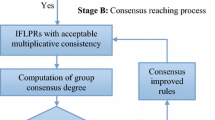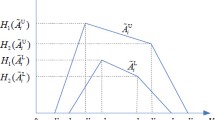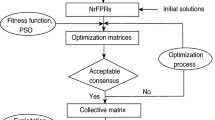Abstract
The interactive group decision-making method with dual probabilistic linguistic term sets (DPLTSs) is talked about in this paper. The benefit of choosing DPLTSs is that they take into account both random and stochastic uncertainties at the same time. The DPLTSs are superior to hesitant fuzzy sets (HFSs), probabilistic HFSs, and probabilistic dual HFSs with uncertainty. Here, we combine the merits of DPLTSs, the Archimedean copula aggregator, and the generalized Maclaurin symmetric mean (GMSM) operator and develop a consensus-based group decision-making methodology. In this methodology, the concepts of consistency and similarity between the experts are used to calculate their weights of subjective and objective types, respectively. We propose an optimization model based on cross-entropy measure and dispersion measure to generate the criteria weights. For aggregating preferences, we propose DPL weighted GMSM aggregation operator utilizing the Archimedean Copula operations between DPL elements. A case study exhibits the proposed method's applicability in group decision-making. The sensitivity analysis of criteria weights establishes the stability of the developed approach. To validate the robustness of the suggested method, a comparison study has been performed, which ensures the effectiveness of the proposed methodology.
Similar content being viewed by others
Data availability
No data were used to support this study.
References
Akram M, Zahid S (2023) Group decision-making method with Pythagorean fuzzy rough number for the evaluation of best design concept. Granular Computing 8(6):1121–1148
Akram M, Habib A, Allahviranloo T (2022) A new maximal flow algorithm for solving optimization problems with linguistic capacities and flows. Inf Sci 612:201–230
Akram M, Niaz Z, Feng F (2023) Extended CODAS method for multi-attribute group decision-making based on 2-tuple linguistic Fermatean fuzzy Hamacher aggregation operators. Granul Comput 8(3):441–466
Bacigal T, Mesiar R, Najjari V (2015) Generators of Copulas and aggregation. Inf Sci 306:81–87
Beliakov G, Pradera A, Calvo T (2007) Aggregation functions: a guide for practitioners. In: Kacprzyk (ed) Studies in fuzziness and soft computing. Springer, Berlin
Bonferroni C (1950) Sulle medie multiple di potenze. Bulletin Math Italiana 5(3):267–270
Cheng X, Gu J, Xu ZS (2018) Venture capital group decision-making with interaction under probabilistic linguistic environment. Knowl Based Syst 140:82–91
Dai S, Zheng J (2023) On probabilistic linguistic term set operations. J Intell Fuzzy Syst 44(6):9993–10003
Feng F, Zhang C, Akram M, Zhang J (2023) Multiple attribute decision making based on probabilistic generalized orthopair fuzzy sets. Granul Comput 8(4):863–891
Gou XJ, Xu ZS, Liao H (2017) Multi-criteria decision making based on Bonferroni means with hesitant fuzzy linguistic information. Soft Comput 21:6515–6529
Grabisch M, Maricha JL, Mesiar R, Pap E (2011) Aggregation functions: Construction methods, conjunctive, disjunctive and mixed classes. Inf Sci 181:23–43
Han XL, Li SR (1994) The priority method in view of consistency harmonious weight index. Syst Eng-Theory Methodol 3(1):41–45
Han B, Tao Z, Chen H, Zhou L, Liu J (2020) A new computational model based on Archimedean copula for probabilistic unbalanced linguistic term set and its application to multi-attribute group decision-making. Comput Ind Eng 140:106264
Han X, Zhang C, Zhan J (2022) A three-way decision method under probabilistic linguistic term sets and its application to air quality index. Inf Sci 617:254–276
Herrera F, Martinez L (2000) A 2-tuple fuzzy linguistic representation model for computing with words. IEEE Trans Fuzzy Syst 8:746–752
Krishankumar R, Saranya R, Nethra RP, Ravichandran KS, Kar S (2019) A decision-making framework under probabilistic linguistic term set for multi-criteria group decision-making problem J. Intell Syst 36(6):5783–5795
Li B, Xu ZS, Zhang YX (2020) A probabilistic linguistic evaluation based multi-stage medical system selection process related to referral system. Expert Syst Appl 170:114523
Liao H, Wu X (2020) DNMA: A double normalization-based multiple aggregation method for multi-expert multi-criteria decision making. Omega 94:102058. https://doi.org/10.1016/j.omega.2019.04.001
Liao H, Jiang L, Xu Z, Xu J (2017) A linear programming method for multiple criteria decision making with probabilistic linguistic information. Inf Sci 416:341–355
Liao H, Mi X, Xu X (2020) A survey of decision-making methods with probabilistic linguistic information: bibliometrics, preliminaries, methodologies, applications and future directions. Fuzzy Optim Decis Making 19:81–134
Liu P, Teng F (2019) Probabilistic linguistic TODIM method for selecting products through online product reviews. Inf Sci 485:441–455
Liu P, Wang Y (2020) Multiple-attribute decision-making based on q-rung orthopair fuzzy generalized Maclaurin symmetric mean operators. Inf Sci 518:181–210
Maclaurin C (1729) A second letter to Martin Folkes, Esq concerning the roots of equations, with demonstration of other rules of algebra. Philos Trans R Soc Lond 36:59–96
Mishra AR, Rani P, Hezam IM, Devechi M (2023) Dual probabilistic linguistic full consistency additive ratio assessment model for medical equipment supplier selection. Int J Fuzzy Syst 25(8):3216–3232
Nather W (2010) Copulas and t-norms: Mathematical tools for combining probabilistic and fuzzy information with application to error propagation and interaction. Struct Saf 32:366–371
Nelsen RB (2013) An introduction to Copula. Springer Science and Business Media, Lecture Notes in Statistics. Springer New York, https://doi.org/10.1007/978-1-4757-3076-0
Pang Q, Wang H, Xu ZS (2016) probabilistic linguistic term sets in multi-attribute group decision making. Inf Sci 369:128–143
Ramadass S, Krishankumar R, Ravichandran KS, Liao H, Kar S (2020) Evaluation of cloud vendors from probabilistic linguistic information with unknown/partial weight values. Appl Soft Comput 97:106801
Rodríguez RM, Martínez L, Herrera F (2012) Hesitant fuzzy linguistic term sets for decision making. IEEE Trans Fuzzy Syst 20:109–119
Saha A, Senapati T, Yager RR (2021) Hybridizations of Generalized Dombi operators and Bonferroni Mean operators under dual probabilistic linguistic environment for group decision-making. Int J Intell Syst 36(11):6645–6679
Saha A, Simic V, Senapati T, Dabic-Miletic S, Ala A (2023a) A dual hesitant fuzzy sets based methodology for advantage prioritization of zero-mile delivery solutions for sustainable city logistics. IEEE Trans Fuzzy Syst 31(2):407–420
Saha A, Mishra AR, Rani P, Senapati T, Yager RR (2023b) A dual probabilistic linguistic MARCOS approach based on the generalized Dombi operator for decision-making. Iran J Fuzzy Syst 20(2):83–102
Sklar M (1959) Fonctions de repartition a n dimensions et leurs marges. Universite Paris 8:229–231
Tao Z, Han B, Chen H (2018) On Intuitionistic fuzzy Copula aggregation operators in multiple-attribute decision-making. Cogn Comput 10:610–624
Wang JQ, Yang Y, Li L (2020) Multi criteria decision-making method based on single valued neutrosophic linguistic Maclaurin symmetric mean operators. Neural Comput Appl 30(5):1529–1547
Wang Z, Cai Q, Lu J, Wei G (2023) MABAC method based on cumulative prospect theory for MCGDM with dual probabilistic linguistic term set and application to sustainable supplier selection. J Intell Fuzzy Syst 45(3):3587–3608
Wei G, Wei C, Wu J, Guo Y (2021) Probabilistic linguistic multiple attribute group decision making for location planning of electric vehicle charging stations based on the generalized Dice similarity measures. Artif Intell Rev 54:4137–4167
Xie W, Xu ZS, Ren Z (2017) Dual probabilistic linguistic term set and its application on the multi-criteria group decision-making problems. In: 2017 IEEE International Conference on industrial engg. and engg. management. IEEE, pp 1469–1474
Xie W, Xu ZS, Ren Z, Viedma EH (2020) A new multi-criteria decision-making model based on incomplete dual probabilistic linguistic preference relations. Appl Soft Comput 91:106237
Xue WT, Xu ZS, Mi X, Ren ZL (2021) Dynamic reference point method with probabilistic linguistic information based on the regret theory for public health emergency decision-making. Econ Res Ekonomska Istrazivanja 34(1):3355–3381
Yager RR (1988) On ordered weighted averaging aggregation operators in multi-criteria decision-making. IEEE Trans Syst Man Cybern 18(1):183–190
Zadeh LA (1975) The concept of a linguistic variable and its application to approximate reasoning-I. Inf Sci 8(3):199–249
Zahid K, Akram M (2023) Multi-criteria group decision-making for energy production from municipal solid waste in Iran based on spherical fuzzy sets. Granul Comput 8(6):1299–1323
Zahid K, Akram M, Kahraman C (2022) A new ELECTRE-based method for group decision-making with complex spherical fuzzy information. Knowl-Based Syst 243:108525
Funding
There is no specific funding for this project.
Author information
Authors and Affiliations
Contributions
Abhijit Saha: Conceptualization, Methodology, Software, Validation, Visualization, Investigation, Writing - Original Draft, Review & Editing. Tapan Senapati: Conceptualization, Writing - Original Draft, Review & Editing. Muhammad Akram: Writing - Original Draft, Review & Editing. Cengiz Kahraman: Conceptualization, Visualization, Writing - Original Draft, Review & Editing. Radko Mesiar: Writing - Original Draft, Review & Editing. Leena Arya: Writing - Original Draft, Review & Editing. All authors reviewed the manuscript.
Corresponding authors
Ethics declarations
Conflict of interest
The authors declare no conflict of interest.
Ethical approval
This article does not contain any studies with human participants or animals performed by the author.
Additional information
Publisher's Note
Springer Nature remains neutral with regard to jurisdictional claims in published maps and institutional affiliations.
Supplementary Information
Below is the link to the electronic supplementary material.
Rights and permissions
Springer Nature or its licensor (e.g. a society or other partner) holds exclusive rights to this article under a publishing agreement with the author(s) or other rightsholder(s); author self-archiving of the accepted manuscript version of this article is solely governed by the terms of such publishing agreement and applicable law.
About this article
Cite this article
Saha, A., Senapati, T., Akram, M. et al. Dual probabilistic linguistic consensus reaching method for group decision-making. Granul. Comput. 9, 35 (2024). https://doi.org/10.1007/s41066-024-00458-6
Received:
Accepted:
Published:
DOI: https://doi.org/10.1007/s41066-024-00458-6




